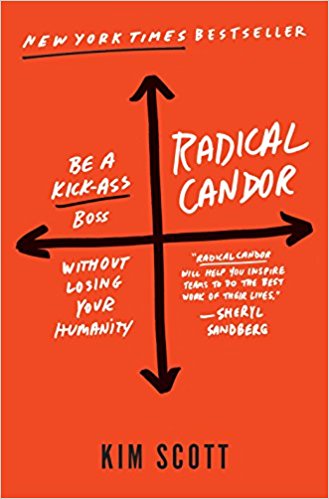Radical Candor, by Kim Scott. NY: St. Martin’s Press. 2017. 232 pages.
Kim Scott starts her excellent management book by telling a story about one of her employees in the first company she owned. “Bob” was a kind, funny, caring, and supportive colleague. There was just one problem: his work was terrible. She liked Bob, and didn’t want to come down too hard on him. So she didn’t tell him how bad his work was, or how his poor work affected the rest of the team. She didn’t tell him how much he was screwing up. The rest of the team covered for him, and morale suffered.
Eventually, she had to fire him. But it was too late. The dysfunctional team had gotten such poor results that, before long, the entire company failed.
This situation resulted in dire consequences, but it led Scott to try to understand what had happened. Over time, she developed a management philosophy that she calls “Radical Candor.” This is what happens when a manager puts “caring personally” with “challenging directly” together.
Managers need to get to know their direct reports. They can’t know everyone in the company well, but they can share more than just their work selves with the people who report directly to them. “It’s not just business; it is personal, and deeply personal,” says Scott.
Managers also need to be willing to tell people when their work isn’t good enough, and when it is. According to Scott, challenging people is often the best way to show them that you care when you’re the boss.
These two dimensions, when combined well, result in Radical Candor. “When people trust you and believe you care about them, they are much more likely to 1) accept and act on your praise and criticism; 2) tell you what they really think about what you are doing well and, more importantly, not doing so well; 3) engage in this same behavior with one another, meaning less pushing the rock up the hill again and again; 4) embrace their role on the team; and 5) focus on getting results.”
The first section of the book describes the philosophy behind Radical Candor and goes into depth about the lessons Scott learned while working as a mid-level manager at Google, Apple, and other companies. For example, “Care Personally” and “Challenge Directly” can result in Radical Candor, if combined well, but they can also result in Ruinous Empathy, Manipulative Insincerity, or Obnoxious Aggression if combined poorly. She explains how to avoid the negative aspects of this combination, and tells anecdotes about mistakes she and others made before they got Radical Candor correct.
The book’s second section gives detailed suggestions for how to employ Radical Candor. These suggestions are interesting and helpful, both for new and experienced managers.
One of my favorite sections is about how to fire a poorly performing employee. In terms of knowing when it’s time to fire them, Scott asks: Have you given Radically Candid guidance? How is the person’s poor performance affecting the rest of the team? Have you sought out a second opinion, spoken to someone whom you trust and with whom you can talk the problem through?
If you have considered all these, you will need to think about the lies managers tell themselves to avoid firing somebody who needs to be fired. These include: it will get better, somebody is better than nobody, a transfer is the answer, and it’s bad for morale to fire someone.
When you have considered these lies, and you still need to fire that person, the way you do it matters. It’s important to feel the pain that is inherent in the situation, to recall a job that you were terrible at and think how glad you feel that you’re no longer in it. When you fire someone, you create the possibility for the person to excel and find happiness performing meaningful work elsewhere. Just because the person isn’t good at this job doesn’t mean there isn’t another job out there they could be great at.
Every organization has a process for firing people, and it’s important to follow that completely. The process usually involves consulting with human resources, your peers, and your own manager about what you are doing. When you do fire the person, make sure to show that you care about him/her while you also explain exactly why you are terminating their employment. Scott emails people she has fired about a month later, just to check in. She tries to find them jobs for which they are better suited. Even if that doesn’t happen, she keeps in touch.
The book includes many practical suggestions for how to create and implement Radical Candor in your team. The writing is clear, and the author’s thoughtfulness and caring are demonstrated on every page. Radical Candor offers a guide to those bewildered or exhausted by management, and it is written for bosses and anyone who has a boss.

